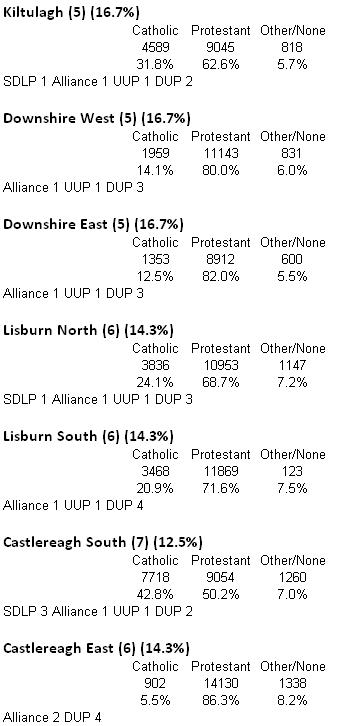And so we continue with Faha’s series looking at Lisburn and Castlereagh (Famous for their openness and embracing attitude towards new media 😉 ). Nice to see Faha getting some kudos from Nicolas Whyte over on Slugger for this series and well deserved in my opinion.
This 9th analysis of the new district councils will cover the new Lisburn Castlereagh district council. This new council comprises the majority of the current Lisburn and Castlereagh councils. However, large areas of the current councils were transferred to the new Belfast council so there have been significant boundary changes at the interface between Belfast and Lisburn and Castlereagh. Approximately 85% of the population of the Dunmurry Cross DEA, 40% of the Castlereagh West DEA, 25% of the Castlereagh East DEA and almost the entire Castlereagh Central DEA were transferred to Belfast City Council. A small section of the Drumbo ward was also transferred to Belfast. The demographic breakdown of the new council is 23.95% Catholic, 66.9% Protestant, 1.07% Other and 8.08% None. The following shows the change in the turnout for the nationalist and unionist parties comparing the 2005 and 2011 district council elections.
The election turnout for the 2005 and 2011 elections indicate:
#1 There was a steep decline in turnout between the 2005 and 2011 elections.
#2 In Lisburn, nationalist turnout is much lower than unionist turnout. The only exception is Dunmurry Cross and most of Dunmurry Cross has been transferred to Belfast. Lisburn South has the lowest nationalist turnout of all DEA’s in Northern Ireland. The nationalist turnout in 2011, especially in Lisburn South, is what one would expect with an organized nationalist boycott of the election. Indeed, 2,500 additional nationalist voters would have had to vote in 2011 in order to equal unionist turnout in the 4 DEA’s that will remain in Lisburn Castlereagh.
#3 In Castlereagh, nationalist voter turnout for the West, South and Central DEA’s was slightly higher than unionist turnout in the 2005 election but declined at a greater rate than unionist turnout and equaled the unionist turnout in 2011.
#4 In the 2011 Assembly election, nationalist voter apathy (approximately 2,300 voter deficit within the Lagan Valley boundaries) resulted in no nationalist representation from Lagan Valley in the Assembly. The SDLP candidate was 1,700 short of a quota on the final count.
The change in the party vote between 2005 and 2011 is as follows:
In Lisburn, there was a large shift of SDLP voters to SF in Dunmurry. In the other 4 DEA’s the SF and SDLP vote increased. However, the nationalist turnout decreased by an average of 10% per DEA because of the large increase in the nationalist electorate. This increase in electorate is mainly due to Catholics moving into Lisburn from Belfast and elsewhere. Few of these additional voters actually vote which accounts for the decline in turnout. There was a huge collapse in the UUP vote. In Killultagh they defected to Alliance but in the other DEA’s the UUP voters stayed home. The DUP vote was also down slightly.
In Castlereagh, there was also a huge collapse in the UUP vote. In the East and West DEA’s it defected to Alliance. The decline in the DUP vote was almost as massive as the decline for the UUP. There was some defection of SDLP voters to SF in the West DEA and a few in the South DEA. There has been a large increase in the nationalist electorate in the West, South and Central DEA’s but no increase in votes for nationalist candidates. This accounts for the large decline in nationalist turnout between 2005 and 2011.
The new DEA’s bear little resemblance to the old ones (see map). Castlereagh East lost 2 wards to Belfast and added Moneyreagh. Castlereagh South was merged with half of Castlereagh West. In Lisburn, the current Killultagh and Downshire DEA’s were rearranged into 3 separate DEA’s. The predicted election results are based on the 2011 turnout.

The average ward electorate is 2372. The total electorate and average ward electorate for each DEA is.
Killultagh 12872 (2574)
Downshire West 11691 (2338)
Downshire East 11535 (2307)
Lisburn South 14544 (2424)
Lisburn North 14285 (2381)
Castlereagh South 16342 (2335)
Castlereagh East 13645 (2274)
It is difficult to compare the party makeup of the current councils with the new councils because all of the Castlereagh Central, most of the Dunmurry Cross and much of the Castlereagh East and West DEA’s have been transferred to Belfast. For purposes of comparison I have used the election results for all of the current DEA’s except Dunmurry Cross and Castlereagh Central since only small sections of these DEA’s will be within the new council. The parties had the following makeup after the 2011 elections.
SF 0 SDLP 4 Alliance 7 Green 1 UUP 7 DUP 21
Total 40
The expected party strength in the new council with the new DEA boundaries:
SF 0 SDLP 5 Alliance 8 Green 0 UUP 6 DUP 21
Total 40
Similar to Mid and East Antrim, this will be a DUP dominated council. Unlike Mid and East Antrim, there is a rapid growth of the Catholic population in most of the new council. It was over 5% in the Lisburn area (the Lagan Valley constituency increase from 13% to over 18%) and also 5% in the Castlereagh area. Even in the 2014 election, if nationalist turnout equaled unionist turnout, there would be a SDLP seat in Lisburn South and a SF seat in Killultagh. Both of these would be at the expense of the DUP. There would still be 25 DUP and UUP councilors. In another 15 or 20 years there could be additional nationalist councilors in Lisburn North, South, Downshire East and West and Castlereagh South ( possibly Alliance here instead). This may not be a unionist dominated council in 15 to 20 years.




Another place where in 15-20 years there will be unionist retreat, at current trends. If Faha’s analysis doesn’t wake up the officials of the DUP and UUP, I don’t know what will.
LikeLike
They got 3 SDLP out of 40 (and an SF free zone) so relax,
LikeLike
My head’s spinning with all these numbers. congratulations to faha who can handle them so masterly.
Could I possibly send in a request, please?
A final summary sheet of his/her predictions like for example newtownabbey SF X, DUP Y, UUP Z etc? Just asking like, to make things easy on Election Night!!!
LikeLike
as it is Poots territory did anyone hear him acknowledge that demographics are in play the other night when he was asking what was the point of the troubles? I think that was the first time I heard a prominent DUPer accept that change is on the way
LikeLike